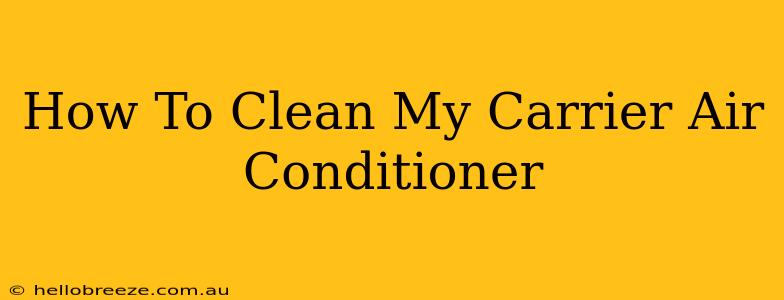Keeping your Carrier air conditioner clean is crucial for optimal performance, energy efficiency, and a healthier home environment. A dirty AC unit can reduce cooling power, increase energy bills, and even contribute to poor indoor air quality. This comprehensive guide will walk you through the process of cleaning your Carrier air conditioner, ensuring you enjoy cool, comfortable air all summer long.
Why Clean Your Carrier Air Conditioner?
Regular cleaning of your Carrier AC unit offers several key benefits:
- Improved Efficiency: A clean condenser coil allows for efficient heat transfer, maximizing your AC's cooling capacity and minimizing energy consumption. This translates to lower electricity bills and a smaller carbon footprint.
- Longer Lifespan: Removing dirt, dust, and debris prevents damage to internal components, extending the lifespan of your Carrier air conditioner and saving you money on costly repairs or replacements.
- Enhanced Air Quality: A clean AC unit filters out dust, pollen, and other allergens, contributing to a healthier indoor environment, particularly beneficial for allergy sufferers.
- Preventing Breakdowns: Regular maintenance, including cleaning, helps prevent unexpected breakdowns during peak summer months, ensuring uninterrupted cooling.
What You'll Need:
Before you begin, gather these essential supplies:
- Garden Hose with Spray Nozzle: A strong stream of water is essential for rinsing away dirt and debris.
- Soft-Bristled Brush: Use this to gently remove loose dirt and debris from the condenser coil fins. Avoid stiff brushes, which can damage the fins.
- Vacuum Cleaner with a Brush Attachment: Useful for removing dust and debris from hard-to-reach areas.
- Fin Comb (Optional): This specialized tool can help straighten bent fins, improving airflow.
- Safety Glasses: Protect your eyes from flying debris.
- Gloves: Protect your hands from dirt and grime.
- Ladder (if needed): Ensure safe access to the outdoor unit.
Cleaning Your Carrier Air Conditioner: A Step-by-Step Guide
1. Safety First: Always disconnect the power to your air conditioner before beginning any cleaning. This is crucial for your safety and prevents electrical shocks. Locate your breaker box and switch off the appropriate breaker.
2. Prepare the Area: Clear any debris, grass clippings, or leaves around the outdoor unit (condenser). This will prevent them from being blown around during cleaning.
3. Clean the Condenser Coils: Gently use the soft-bristled brush to remove loose dirt and debris from the condenser coil fins. Work carefully to avoid bending or damaging the fins. A vacuum cleaner with a brush attachment can be helpful for reaching hard-to-access areas.
4. Rinse with Water: Once the loose dirt is removed, use the garden hose with a spray nozzle to rinse the condenser coils. Use a gentle spray to avoid bending the fins. Focus the water stream on the coils, ensuring all dirt and debris are washed away. Allow the unit to air dry completely before turning it back on.
5. Straighten Bent Fins (Optional): If you notice any bent fins, carefully use a fin comb to straighten them. This will improve airflow and efficiency.
6. Clean the Air Filter: Locate the air filter inside your indoor unit (evaporator). Remove the filter and either vacuum or wash it with mild detergent and water. Allow it to dry completely before reinstalling it. Consult your Carrier air conditioner's manual for specific instructions on filter cleaning.
7. Restore Power: Once the unit is completely dry, restore the power to your air conditioner by switching the breaker back on.
Maintaining Your Carrier Air Conditioner
Cleaning your Carrier air conditioner should be performed at least twice a year, once in spring before the cooling season begins and again in the fall after the cooling season ends. Regular cleaning will ensure optimal performance, extend the lifespan of your unit, and help you save money on energy costs. For more extensive maintenance or repairs, always contact a qualified Carrier technician.
Contact a Professional
While this guide provides a helpful overview, some issues require professional attention. If you notice unusual noises, reduced cooling capacity, or any other problems, it's best to contact a qualified HVAC technician for professional service. Don't attempt major repairs yourself, as this could void your warranty and potentially damage your unit. Regular professional maintenance will ensure your Carrier air conditioner operates efficiently and reliably for years to come.

